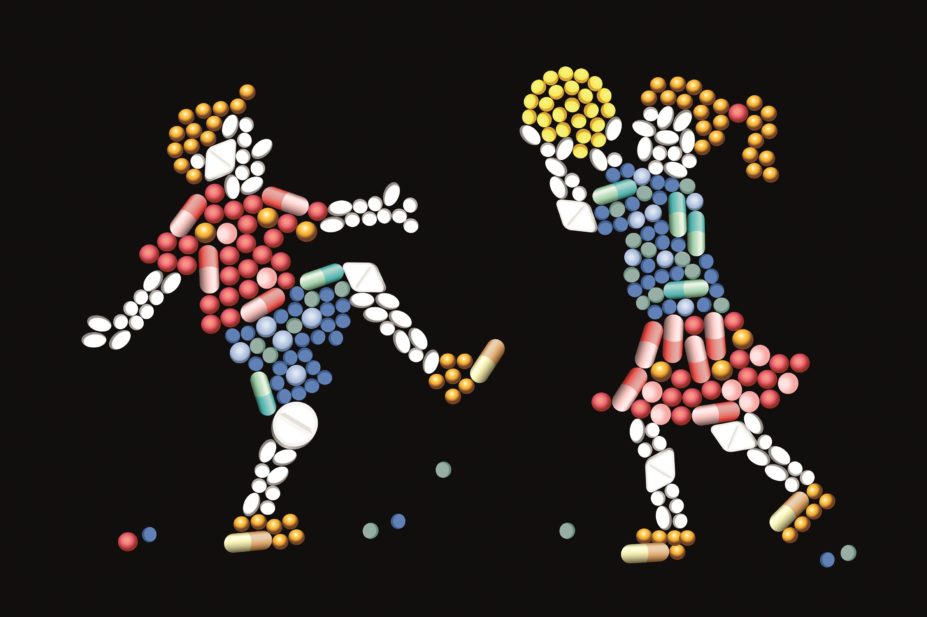
istockphoto.com
The second generation of antipsychotics, dubbed the “atypicals”, were hailed as a breakthrough for the treatment of schizophrenia upon their introduction to the market in the 1990s, with risperidone being the first. By 2000, they were praised for providing a much-needed treatment option for people with bipolar I disorder, a condition with around a 1% prevalence rate. The dual effect of atypical antipsychotics in impacting dopamine and serotonin levels was soon applied to more common conditions, including dementia, depression, anxiety, children who behave badly, and broadly defined mild mental malaise, opening up much more lucrative markets.
Leaked pharmaceutical industry documents from the late 1990s to mid-2000s detailed marketing campaigns in which inconvenient scientific data were described inaccurately or suppressed and criteria for mental disorders were stretched to include a vast target range of patients[1],[2]
. Atypical antipsychotics were promoted as treatments for conditions for which they possess a questionable risk-benefit ratio or for which there is no supporting evidence at all[1],[3]
, with the added risk of weight gain, movement disorders, stroke and heart attack. Some pharmaceutical companies sought to increase profits by marketing these drugs to mildly disaffected people[4] and expanding the definitions of mental illness to include things such as “complicated mood”[1]
. In UK primary care settings, antipsychotics are widely prescribed for depression, anxiety, sleep and personality disorders (about 2:1 atypical to typical antipsychotic ratio)[5]
.
Even in schizophrenia — the condition for which atypical antipsychotics seem most effective — the benefits were oversold and the risks understated[6]
. To push widespread adoption of atypical antipsychotics for a wide variety of ills, the usual sales tactics were used, including: direct-to-consumer advertising (in the United States); sales visits to prescribers; touting overly optimistic cost-effectiveness research; free drug samples; sponsored medical education; peer-to-peer marketing (paying physicians to market to their peers); funding patient advocacy groups; and, perhaps most importantly, biased presentation of evidence in medical journal articles. For instance, internal documents indicate that unfavourable data regarding quetiapine were “buried” to help maintain a positive image of the drug in the scientific literature[2]
. To help ensure maximum product uptake, the drug industry also paid state mental health programme officials in Pennsylvania and Texas, despite state rules banning these officials from accepting such payments.
A large body of studies shows alarming trends in prescribing atypical antipsychotics in recent decades. For instance, 12.5% of non-psychotic depressed patients in the United States received a prescription for an atypical antipsychotic in 2009–2010[7]
. Yet, relative to a sugar pill, when an atypical antipsychotic is added to an antidepressant, benefits on functioning or quality of life range between very small and zero[8]
. This did not dissuade US or UK regulatory authorities from approving some atypical antipsychotics as “add-on” treatments for depression, starting in 2007. This says more about the low bar set by regulatory authorities than it does about the efficacy of these drugs as antidepressants[8],[9]
. Furthermore, around 21% of patient visits to psychiatrists for anxiety disorder treatment involved an antipsychotic prescription in 2004–2007, double that of 1996–1999[10]
. Similarly, among depressed patients in the United States Department of Veterans Affairs system (a government-run military veteran benefit system) without a bipolar or schizophrenia diagnosis, 21% received an antipsychotic prescription in 2007. Atypical antipsychotics are widely prescribed as sedatives or sleep aids, again despite a lack of evidence that such an intervention is safe or effective.
Antipsychotic use in children
Children with attention deficit-hyperactivity disorder (ADHD) or conduct disorder are often prescribed atypical antipsychotics. From 2005–2009, medical office visits involving an antipsychotic prescription were much more common for disruptive behaviour problems (63% of child visits and 34% of adolescent visits) than for approved conditions (6% of children and 13% of adolescent visits)[11]
. Furthermore, children with bipolar disorder diagnoses — a peculiarly American phenomenon, defined under the category of bipolar disorder not otherwise specified in the Diagnostic and Statistical Manual of Mental Disorders (DSM)[12]
— also often take antipsychotics. Children behaving badly became a target market from the early 2000s. Clinical trials recruited preschoolers to test antipsychotics for purported bipolar disorder, popular press books such as ‘The bipolar child’ sold widely, and a small group of researchers redefined bipolarity in youth to encompass a much broader spectrum than what appears in the DSM criteria[13]
.
The bipolar child? Mission accomplished. The number of treatment visits for children diagnosed with bipolar disorder in the United States increased by an estimated 4000% from 1994–1995 to 2002–2003. It is unlikely that the widespread use of antipsychotics has brought substantial benefits to kids, although it is likely that substantial weight gain and other well demonstrated adverse effects of atypical antipsychotics have harmed tens of thousands of young people[14],[15]
. Items such as quality of life or general functioning are rarely measured in trials assessing antipsychotics for “bipolar” kids and it is unclear whether the short-term tranquilising effect of antipsychotics leads to improved behaviour over the long term. (Some studies conducted are around a year in duration but the placebo-controlled portion in such studies is only a few weeks.)
Elderly patients with dementia taking antipsychotics die at a higher rate than similar patients taking placebo, yet antipsychotic use for dementia is common. One study found that, in 2004, nearly a quarter of nursing home residents in the United States received an atypical antipsychotic prescription[16]
. However, some evidence suggests decreased prescribing of such drugs after a US Food and Drug Administration warning regarding their propensity to hasten death[17]
. Although the United States is the global leader in dispensing atypical antipsychotics, much of the developed world has followed suit. A 2009 report commissioned by the UK Department of Health suggested that perhaps 25% of patients with dementia in the UK were receiving antipsychotic medicines. Among nursing home residents in Germany, antipsychotics are the second-most prescribed class of medicines[18]
, trailing only analgesics (although typical antipsychotics are still prescribed more than atypicals). Antipsychotics are also frequently prescribed for treating dementia in several European countries, including Austria[19]
, Sweden[20] and others.
A different approach
Given the unconvincing or lack of evidence for atypical antipsychotics, what else can help people suffering from mental distress? For depression and anxiety (including post-traumatic stress disorder), several psychotherapies have demonstrated efficacy in adults — and lack the substantial adverse effects generated by atypical antipsychotics[21],[22],[23]
. For dementia, non-medication approaches may improve behavioural and psychological symptoms. Granted, scaling up such programmes for wide use comes at a cost, but it dishonours the elderly to treat them with antipsychotics instead, which provide little efficacy and substantial risk. Treating children with substantial disruptive behaviours is challenging, to the point that antipsychotics can appeal to parents and physicians. Yet various psychological approaches have evidence for improving disruptive and delinquent behaviours[24]
, and these strategies should be exhausted before turning to atypical antipsychotics to manage ADHD, conduct disorder and other troubling issues. Even when better supported interventions have failed, prescribers should be aware that atypical antipsychotics often fail to bring more benefit than harm.
Prescribers should carefully discuss potential adverse drug effects with patients. Furthermore, all parties should be aware that adverse event rates reported in clinical trials tend to be on the lower side of estimates owing to a lack of structured assessment and incomplete reporting of data[25]
. Many prescribers allow themselves to be “educated” by sales representatives and drug firm-sponsored continuing education. This hardly qualifies as decent education. Pharma owns all data from the clinical trials and weaves such data into journal articles, which make its products appear safer and more effective than they really are[2]
. Prescribers need a healthy sense of scepticism when assessing evidence for and against a certain treatment.
History will not recall the current era of widespread antipsychotic use kindly. Much more judicious use of these treatments is urgently needed.
Glen I Spielmans is an associate professor of psychology at Metropolitan State University and an adjunct associate research professor of counselling psychology at the University of Wisconsin-Madison.
References
[1] Spielmans GI. The promotion of olanzapine in primary care: an examination of internal industry documents. Soc Sci Med. 2009;27(69):14–20.
[2] Spielmans GI & Parry PI. From evidence-based medicine to marketing-based medicine: Evidence from internal industry documents. J Bioethical Inq. 2010;7:13–29.
[3] Groeger L. Big Pharma’s Big Fines. ProPublica. 2014.
[4] Healy M. Use of atypical antipsychotics for lesser disorders is gaining ground, despite safety concerns. Los Angeles Times. 13 April 2009.
[5] Marston L, Nazareth I, Petersen I et al. Prescribing of antipsychotics in UK primary care: a cohort study. BMJ Open 2014;4(12):e006135.
[6] Jones PB, Barnes TR, Davies L et al. Randomized controlled trial of the effect on quality of life of second- vs first-generation antipsychotic drugs in schizophrenia: cost utility of the latest antipsychotic drugs in schizophrenia study (CUtLASS 1). Arch Gen Psychiatry 2006;63:1079–1087.
[7] Gerhard T, Akincigil A, Correll CU et al. National trends in second-generation antipsychotic augmentation for nonpsychotic depression. J Clin Psychiatry 2014;75:490–497.
[8] Spielmans GI, Berman MI, Linardatos E et al. Adjunctive atypical antipsychotics for major depressive disorder: A meta-analysis of depression, quality of life, and safety outcomes. PLoS Med. 2013;10:e1001403.
[9] Spielmans GI & Kirsch I. Drug approval and drug eEffectiveness. Annu Rev Clin Psychol. 2013;10:741–766.
[10] Comer JS, Mojtabai R & Olfson M. National trends in the antipsychotic treatment of psychiatric outpatients with anxiety disorders. Am J Psychiatry. 2011;168:1057–1065.
[11] Olfson M, Blanco C, Liu S et al. 2012. National trends in the office-based treatment of children, adolescents, and adults with antipsychotics. Archives of General Psychiatry 2012;69:1247–1256.
[12] Parry PI, Allison S & Bastiampillai T. Reification of the paediatric bipolar hypothesis in the USA. Lancet Psychiatry 2015;2:14–16.
[13] Healy D & Le Noury J. Pediatric bipolar disorder: An object of study in the creation of an illness. Int J Risk Saf Med. 2007;19:209–221.
[14] Correll CU & Carlson HE. Endocrine and metabolic adverse effects of psychotropic medications in children and adolescents. J Am Acad Child Adolesc Psychiatry 2006;45(7):771–791.
[15] McIntyre RS & Jerrell JM. Metabolic and cardiovascular adverse events associated with antipsychotic treatment in children and adolescents. Arch Pediatr Adolesc Med. 2008;162(10):929–935.
[16] Kamble P, Chen H, Sherer J et al. Antipsychotic drug use among elderly nursing home residents in the United States. Am J Geriatr Pharmacother. 2008;6:187–197.
[17] Kales HC, Zivin K, Kim HM et al. Trends in antipsychotic use in dementia 1999–2007. Arch Gen Psychiatry 2011;68:190–197.
[18] Richter T, Mann E, Meyer G et al. Prevalence of psychotropic medication use among German and Austrian nursing home residents: a comparison of 3 cohorts. J Am Med Dir Assoc. 2012;13(2):187.e7–187.e13.
[19] Gustafsson M, Karlsson S & Lövheim H. Inappropriate long-term use of antipsychotic drugs is common among people with dementia living in specialized care units. BMC Pharmacol Toxicol. 2013;14:10.
[20] Huber M, Kölzsch M, Rapp MA et al. Antipsychotic drugs predominate in pharmacotherapy of nursing home residents with dementia. Pharmacopsychiatry 2012;45:182–188.
[21] Cuijpers P, Straten A van, Andersson G et al. Psychotherapy for depression in adults: A meta-analysis of comparative cutcome studies. J Consult Clin Psychol. 2008;76:909–922.
[22] Benish SG, Imel ZE & Wampold BE. The relative efficacy of bona fide psychotherapies for treating post-traumatic stress disorder: A meta-analysis of direct comparisons. Clin Psychol Rev. 2008;28:746–758.
[23] Hofmann SG & Smits JAJ. Cognitive-behavioral therapy for adult anxiety disorders: A meta-analysis of randomized, placebo-controlled trials. J Clin Psychiatry 2008;69:621–632.
[24] Borduin CM, Mann BJ, Cone LT et al. Multisystemic treatment of serious juvenile offenders: Long-term prevention of criminality and violence. J Consult Clin Psychol. 1995;63:569–578.
[25] Zimmerman M, Galione JN, Attiullah N et al. Underrecognition of clinically significant side effects in depressed outpatients. J Clin Psychiatry 2010;71:484–490.


